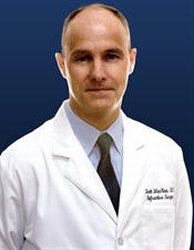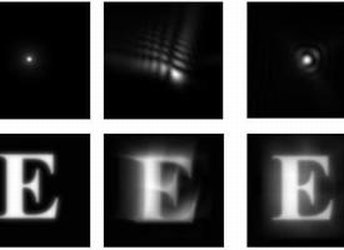UR Technology to Enhance Eyesight Approved by FDA …
UR Technology to Enhance Eyesight Approved by FDA
Patients at Flaum Eye Institute Were First to Benefit from Latest


Scott MacRae, M.D.
March 16, 2011
A technology created by University of Rochester physicians and scientists that has helped boost the eyesight of patients to unprecedented levels is now more widely available, thanks to approval by the U.S. Food and Drug Administration.
The technology, called the Rochester Nomogram, marks a leap forward for patients who receive refractive surgery, also broadly known as LASIK. Refractive surgeon Scott MacRae, M.D., helped develop the formula which has helped him achieve nearly unparalleled results in broad groups of patients.

MacRae takes measurements of low light levels that people typically encounter when driving at night. The technology he has helped develop improves vision for patients in such situations
With the aid of the Nomogram, a remarkable 99.3 percent of the eyes that MacRae operates on have vision of 20/20 or better. That’s one of the best, if not the best, success rates among refractive surgeons in the world.
This week, a company that has licensed the technology from the University announced that the FDA has approved its use in its refractive surgery system. Technolas Perfect Vision is a cataract and refractive laser company that was formed through a joint venture of Bausch + Lomb and 20/10 Perfect Vision AG. It’s currently the only company offering the Nomogram technology in its refractive surgery correction system.
The Nomogram was first created and tested at the University about five years ago by MacRae working together with Manoj Venkiteshwar, Ph.D., who was then a post-doctoral researcher at the University’s Center for Visual Science.

A dot of light as it would appear to someone with perfect vision (left), and how it appears to two people with typical higher-order aberrations. Similarly, the standard “E” as it appears with perfect vision and then with aberrations.
MacRae, the director of the Refractive Surgery Center at the Flaum Eye Institute, had long noted that patients undergoing refractive surgery were much more likely to come out of the surgery slightly far-sighted, though their vision was nearly always 20/20 or better. He and Venkiteshwar studied the problem and created a complex formula that helps physicians understand more thoroughly how refractive surgery affects a person’s eyesight. The Nomogram adjusts the way a laser interacts with a person’s vision, vastly reducing the chances that the patient’s eyes will be near-sighted or far-sighted after the procedure.
“We have a commitment to our patients, to do the very best for them that we can,” said MacRae. “We’ve taken an extraordinarily safe, effective procedure and made it even more effective, not only for our patients here in Rochester, but for patients around the world who will have access to this technology.”
The FDA approval is the latest development in a nearly 20-year-long project by University scientists and physicians to study and improve human vision.
In the early 1990s, scientist David Williams, Ph.D., director of the Center for Visual Science, began a series of experiments to look into the eye in unprecedented detail, not only to see the organ’s fine structures but also to understand how light moves around inside the eye.
His pioneering work opened the door, for the first time in history, to the possibility of fixing not only the three major flaws in the eye that reading glasses and contact lenses have corrected for decades, but also approximately 60 additional imperfections that were never known before. Nearly everyone has these flaws in their eyes to some extent; while most people don’t notice them, they hurt our quality of vision in subtle ways.
MacRae, an internationally recognized refractive surgeon, moved to Rochester in 2000 from Portland, Ore., to help bring the developments to the bedsides of patients and give them a quality of eyesight that was not possible before Williams’ work. Through a series of clinical trials and work in the laboratory, the Rochester team did just that.
The team helped to create a field known as customized ablation, a form of LASIK that corrects subtle imperfections, bringing about a super-crisp quality of eyesight. Beyond making vision on the order of 20/15 or 20/16 possible or even commonplace in some groups of patients, the technology also increases the eye’s ability to see in situations where there is low light or little contrast.
Five years ago, Venkiteshwar and MacRae calculated the subtle effects that customized ablation can have on the eye and how the eye shunts around light. Specifically, they found that fixing subtle imperfections that hadn’t even been recognized before Williams’ work offered new opportunities for enhancing a person’s vision. They developed the Rochester Nomogram to allow surgeons to take advantage of this information during refractive surgery.
“It’s not just the formula or the laser used during surgery that makes the difference,” said MacRae, who is also professor of Ophthalmology and Visual Science. “Re-shaping the cornea to provide better vision is an incredibly complex process. We’ve had more than a decade of experience studying the process in great detail, and that very much plays a role in our ability to help our patients see better than they ever have.”
MacRae is the author of two best-selling books on customized ablation, including Customized Corneal Ablation: The Quest for Supervision. He has trained hundreds of refractive surgeons and has performed refractive surgery on more than 10,000 people during his 25-year career. Recently he was recognized as one of the world’s top 50 most influential people in the realm of cataract and refractive surgery by readers of Cataract and Refractive Surgery Today. MacRae also serves as a consultant for Bausch + Lomb.
* The above story is reprinted from materials provided by University of Rochester Medical Center



















